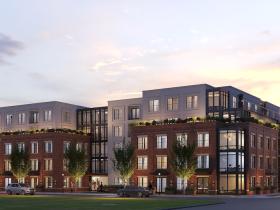 DC is Exploring Income Averaging
DC is Exploring Income Averaging
✉️ Want to forward this article? Click here.
As the District's Department of Housing and Community Development (DHCD) drafts an update to its Qualified Allocation Plan (QAP) for low-income housing tax credits (LIHTC), a newly-available tool could be on the table.
Low-income housing tax credits are a tool used to incentivize private investment in affordable housing for households earning no more than 60 percent of area median income (AMI) by offering a tax credit in the full amount of that investment. Typically, LIHTC would be available in projects where at least 40 percent of the units are rent-restricted for households earning up to 60 percent AMI, or at least 20 percent of the units are rent-restricted for households earning up to 50 percent AMI. Among the many initiatives introduced as part of the federal tax reform bill that passed last year was the concept of income averaging, an additional means of distributing LIHTC funds.
story continues below
loading...story continues above
Income averaging would allow projects that receive LIHTC funding to accommodate households earning up to 80 percent AMI if at least 40 percent of the units are occupied by households earning an average of 60 percent AMI. In theory, income averaging would encourage more income diversity within a development, and would also increase the number of units that could be eligible for LIHTC equity. The tool could also be beneficial for multi-family rental properties undergoing the TOPA process where some households may be moderate-income, potentially making more TOPA buildings eligible for LIHTC funds.
DHCD held a public stakeholder meeting on the QAP last week and reportedly, many of those present responded positively to the idea of income averaging. However, implementation would undoubtedly complicate matters on both the qualifying and monitoring sides of the table, particularly because any project using LIHTC funds via this tool would have to maintain the required balance of income-qualified households through the duration of the affordability covenant.
Additionally, income averaging is similar to Opportunity Zones in the sense that the Internal Revenue Service has yet to release final guidance on how the tool should be governed.
DHCD plans to release a draft of the 2019 QAP by early May, at which point there will be a public hearing and a 30-day commenting period. The final QAP is anticipated to be in place in early June.
See other articles related to: affordable housing, affordable housing dc, dhcd, lihtc, low-income housing tax credit
This article originally published at https://dc.urbanturf.com/articles/blog/dc-is-exploring-this-new-lihtc-tool/15104.
Most Popular... This Week • Last 30 Days • Ever

With frigid weather hitting the region, these tips are important for homeowners to ke... read »

Today, UrbanTurf offers a brief explanation of what it means to lock in an interest r... read »

A new report from DC’s Office of Revenue Analysis highlights how millennials and wo... read »

An application extending approval of Friendship Center, a 310-unit development along ... read »

The 30,000 square-foot home along the Potomac River sold at auction on Thursday night... read »
DC Real Estate Guides
Short guides to navigating the DC-area real estate market
We've collected all our helpful guides for buying, selling and renting in and around Washington, DC in one place. Start browsing below!
First-Timer Primers
Intro guides for first-time home buyers
Unique Spaces
Awesome and unusual real estate from across the DC Metro













